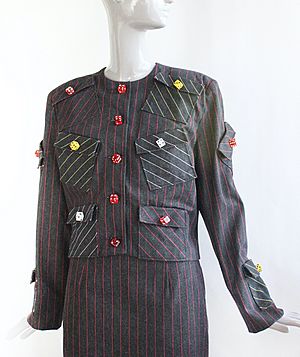Patrick Kelly (fashion designer) facts for kids
Quick facts for kids
Patrick Kelly
|
|
|---|---|

Patrick Kelly in his Paris workshop, ca. 1985
|
|
| Born | September 24, 1954 |
| Died | January 1, 1990 (aged 35) |
| Burial place | Père-Lachaise Cemetery, Paris, France |
| Occupation | Fashion Designer |
| Years active | 1974-1990 |
| Known for | Patrick Kelly Paris |
| Partner(s) | Bjorn Amelan |
Patrick Kelly (September 24, 1954 – January 1, 1990) was a famous American fashion designer. He became very well known in France. He was the first American designer to join a special group called the Chambre syndicale du prêt-à-porter des couturiers et des créateurs de mode. This group sets the standards for French fashion. Kelly's designs were known for being fun, colorful, and often included references to pop culture and Black folklore.
Contents
Early Life and Education
Patrick Kelly was born on September 24, 1954, in Vicksburg, Mississippi. His mother, Letha Mae Kelly, was a home economics teacher. His father, Danie S. Kelly, was a cab driver. Patrick had two brothers, Danie Jr. and William. After his father passed away in 1969, his grandmother helped raise him.
Patrick became interested in fashion when he was in high school. He learned how to sew during this time. After finishing high school in 1972, he went to Jackson State University for a short time. Then, he moved to Atlanta, Georgia.
Fashion Career Highlights
In 1974, while in Atlanta, Patrick Kelly worked at a thrift shop. This job allowed him to find donated designer clothes. He would change these clothes and sell them, along with his own designs. Eventually, he opened his own store in the Buckhead area of Atlanta. He also organized fashion shows and started a modeling agency and clothing line called Longboy.
In 1979, he met Pat Cleveland, a famous Black supermodel. She liked his clothes and told him to move to New York City. After a year in New York, he moved to Paris in 1980, again following Cleveland's advice.
Success in Paris
Patrick found success quickly in Paris. He soon created his unique style: stretchy, brightly colored dresses. These dresses often had colorful buttons and bows. This style was a tribute to the fashionable women he remembered from his childhood in the South. In 1983, Kelly met Bjorn Amelan, who became his partner and helped manage his growing business.
Kelly started selling his designs at popular stores in Paris called Victoire boutiques. One buyer said that Patrick "landed like a bomb" in her shop in 1985 because he was so full of energy. Also in 1985, the French Elle Magazine featured Kelly in a six-page article. During this time, famous people like Bette Davis, Madonna, and Grace Jones started wearing his clothes.
He also worked with jewelry designer David Spada. One of their most famous designs was a Josephine Baker-inspired outfit. It included a banana skirt and is now in the Philadelphia Museum of Art.
Joining the French Fashion World
In 1987, a large fashion company called Warnaco agreed to make Kelly's clothing. With their help, Kelly's designs were sold in stores all over the world. That year, his sales reached almost $7 million.
In 1988, with support from designer Sonia Rykiel, Kelly was accepted into the important Chambre syndicale du prêt-à-porter des couturiers et des créateurs de mode. This made his young brand an official peer of famous labels like Yves Saint Laurent and Chanel. He was the first American designer to join this group. This allowed Kelly to present his fashion shows at The Louvre museum.
Challenging Stereotypes Through Design
Patrick Kelly collected items that showed racial stereotypes. He used these images in his designs in a clever way. His clothes featured things like watermelon slices, black baby dolls, and bananas. He used these images to make people think and to challenge old ideas.
A writer named Robin Givhan said in 2004 that Kelly's race and culture were a very important part of his work. She noted that he was unique in how he used his background in his designs and public image. He wanted to celebrate his heritage.
Kelly wanted his clothes to be for everyone. He told People Magazine in 1987, "I design for fat women, skinny women, all kinds of women. My message is, you're beautiful just the way you are." At one of his shows in 1987, a model who was eight months pregnant walked the runway.
By 1989, Kelly was very successful. He was creating his line for Warnaco and working on other projects. He was also planning new lines like lingerie and perfume. In August of that year, Kelly became very ill. He was unable to finish preparing for his October show. This led to his agreement with Warnaco being canceled. Patrick Kelly passed away on January 1, 1990, due to a serious illness. He was survived by his partner, Bjorn Amelan, and his mother. His friend, Gloria Steinem, spoke at his memorial service. She said that instead of dividing people, he "unified us with buttons and bows." Kelly is buried in the Père-Lachaise cemetery in Paris.
Patrick Kelly's Legacy
Patrick Kelly's work continues to be celebrated. In 2004, The Brooklyn Museum held an exhibit called Patrick Kelly: A Retrospective. It showed 60 of his outfits, along with photos and items from his collection of Black memorabilia. In 2014, the Philadelphia Museum of Art presented Patrick Kelly: Runway of Love. This exhibit celebrated the museum receiving 80 of his designs as a gift.
There are two main places in the United States that keep Kelly's clothing. The Philadelphia Museum of Art has a collection. Also, Jackson State University, where Kelly briefly studied, has about 250 of his items. Jackson State showed some of its collection in 2016. The Schomburg Center in New York City has Kelly's sketchbooks and videos of his fashion shows.



